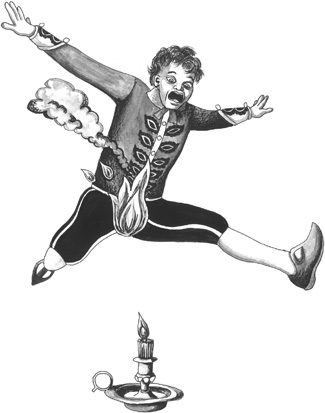
JACK, be nimble,
Jack, be quick,
Jack, jump over
The candlestick.
‘Jack, Be Nimble’ was first published in 1798 and has reappeared in various forms ever since. A couple of versions extend into a second verse:
Jack jumped high,
Jack jumped low,
Jack jumped over and burned his toe.
Over the years, children have used it as a skipping rhyme, no doubt with little thought about the origins of the poem, of which there are three very different theories.
One theory is based on the folk belief that yellow fever, or ‘yellow Jack fever’ – an acute viral disease that was rife in the West until vaccination was developed in the early twentieth century – could be prevented by the presence of fire. The most obvious symptom of fever is the body’s rapid increase of temperature. By having another source of heat nearby, the fever could be drawn out, or so it was believed. During outbreaks, children were often put to bed with a burning candle beside their cots to ward off the illness.
Another suggestion runs that Jack was actually the notorious pirate captain Calico Jack Rackham (1682-1720), so named because of his colourful calico clothing, and that the rhyme celebrates his regular near-miss escapes from the long arm of the law. Jack wasn’t quite nimble enough, it

would appear, as he was eventually captured and hanged, although the equally notorious Mary Read and Anne Bonnie, members of his crew, were saved from execution because of the ‘innocent’ unborn babies they were supposedly carrying.
There is no real evidence to back up either of these suggestions, however. The true origin of the rhyme goes back many centuries. Candle jumping in those times was a traditional method of predicting the future. Quite simply, if the candle stayed alight after a person had ‘jumped it’, then he or she could look forward to a bright and prosperous future. If, however, the flame went out, then things looked rather bleak. Although not as bleak, I imagine, as it would if the candle set light to the jumper’s clothing as he/she passed over it, in which case his/her future would be short and phosphorous.
Candle jumping might be incorporated into other festivities, such as the feast of St Catherine on 25 November, when winter was drawing in and the days getting shorter and darker. Towards the end of the day, bonfires would be lit and fireworks set off, including, quite possibly, Catherine wheels – picturesquely named after the manner of the saint’s martyrdom. Catherine is the patron saint of unmarried women and her festival gave spinsters the opportunity to openly search for a husband. During the festivities, men in costume danced and sang while the ladies served punch and showed off their buns. The whole mad event would be concluded with the placing of a tall candlestick on the ground over which people jumped, one after the other, while the crowd chanted the name of each jumper.
The game of candle leaping has a very long history, in fact, being related to fire leaping, which can be traced back to between five and ten thousand years ago. Bonfires –originally containing animal bones, which accounts for the name – were believed to ward off evil and dangerous spirits; hence many considered that jumping over the flames would bring good fortune – or a good husband.